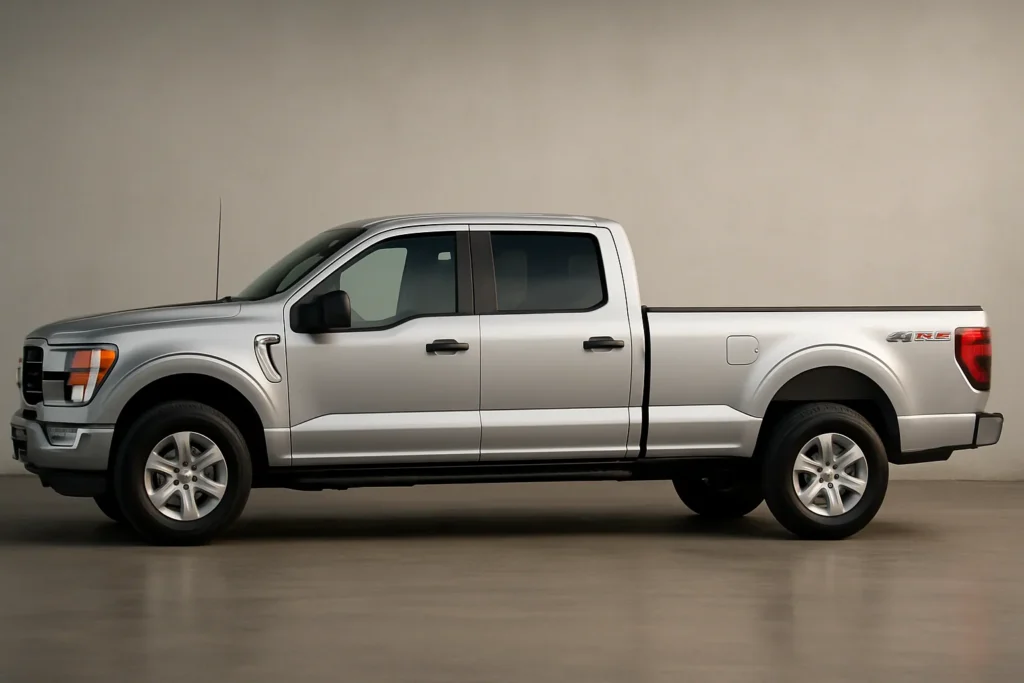If you’ve ever stood next to a Ford F-150, you know it’s not just another pickup. It’s big, bold, and built to work hard. But when it comes to choosing the right one, the question most people ask is simple: How long is it?
Well, here’s the thing — the length of the Ford F-150 isn’t one fixed number. It changes based on how the truck is configured. The cab style, the bed length, and even the trim you choose can all change how much space this beast takes up in your driveway or garage.
So if you’re planning to buy one, park one, or just curious how it stacks up against other full-size trucks, this guide breaks it all down in easy terms. We’ll go through every length, explain what each one means in the real world, and help you figure out which version fits your life best.
Snippet-Ready Definition:
The length of a Ford F-150 ranges from about 209 to 250 inches, depending on cab and bed size. Regular Cabs are shortest, while SuperCrew 8-foot beds are longest.
What the “Length of Ford F-150” Really Means
When Ford lists the length of the F-150, they’re talking about the full distance from the front bumper to the back bumper. It’s also known as the bumper-to-bumper length. This number changes depending on the cab type (Regular, SuperCab, or SuperCrew) and the bed size (5.5-foot, 6.5-foot, or 8-foot).
Here’s the general range:
- The shortest version is around 209 inches long (about 17.4 feet).
- The longest one stretches up to 250 inches (about 20.9 feet).
That’s quite a difference — roughly the length of a full-size sofa. And those few extra feet can make all the difference when you’re parking in tight city garages or pulling into your home driveway.
Ford F-150 Lengths by Configuration
Let’s break down the specific numbers, because this is where most people get confused. The Ford F-150 lineup offers several combinations of cab and bed sizes. Each mix gives you a different total length.
| Configuration | Bed Size | Overall Length (in) | In Feet | In Centimeters |
| Regular Cab / 6.5-foot Bed | 6.5 ft | ~209.1 in | ~17.4 ft | ~531 cm |
| Regular Cab / 8-foot Bed | 8.0 ft | ~227.7 in | ~18.9 ft | ~578 cm |
| SuperCab / 6.5-foot Bed | 6.5 ft | ~231.7 in | ~19.3 ft | ~589 cm |
| SuperCrew / 5.5-foot Bed | 5.5 ft | ~231.7 in | ~19.3 ft | ~589 cm |
| SuperCrew / 6.5-foot Bed | 6.5 ft | ~243.5 in | ~20.3 ft | ~618 cm |
| SuperCrew / 8-foot Bed | 8.0 ft | ~250.3 in | ~20.9 ft | ~636 cm |
Now, let’s walk through what these setups actually mean in everyday terms.
Regular Cab
If you’re after a classic work truck, the Regular Cab is your go-to. It’s the shortest of the bunch, offering just two doors and a single bench or bucket seat setup. The 6.5-foot bed version is the easiest to park and move around town. If you go for the 8-foot bed, you’ll gain more cargo space but lose a bit of maneuverability.
SuperCab
Think of this one as the “in-between” model. It offers small rear doors that open backward and a little extra cabin room without stretching the truck too far. The length of a Ford F-150 SuperCab with a 6.5-foot bed sits around 231 inches, making it a nice balance between passenger comfort and cargo space.
SuperCrew
The SuperCrew, also known as the crew cab, is the most popular option. It’s the one you’ll see families and daily drivers choosing. The length of the Ford F-150 SuperCrew ranges from about 231 to 250 inches depending on bed size. With four full-size doors and a roomy interior, it feels more like an SUV up front but still offers the practicality of a truck.
Length of the Ford F-150 in Feet, Inches, and Centimeters
Different people think in different units, so let’s simplify it. Most F-150s fall between 17 and 21 feet in total length. In inches, that’s roughly 209 to 250 inches. In centimeters, it’s about 5300 to 6400 cm.
Here’s a quick reference for you:
- 209 inches = 17.4 feet (Regular Cab 6.5 ft bed)
- 231 inches = 19.3 feet (SuperCrew 5.5 ft bed)
- 250 inches = 20.9 feet (SuperCrew 8 ft bed)
Why does this matter? Because your garage space might not. Many suburban garages are about 20 feet deep, so the longest F-150s might need careful parking or even tailgate-down adjustments.
Bumper-to-Bumper Length and What It Means for Real Life
When you hear “bumper to bumper length,” it means the entire vehicle length including the front grille, bumpers, and any overhangs. It’s the total space the truck takes up — not just the wheelbase.
If you plan to:
- Park in a standard 20-foot garage
- Fit into city parking spots
- Tow a trailer
then bumper-to-bumper length becomes a major consideration. For example, the SuperCrew 6.5-foot bed stretches over 20 feet, which could leave your garage door just an inch or two from the bumper. Always measure before buying — it saves headaches later.
How Cab Type and Bed Size Affect Total Length
Here’s the thing — the cab and bed are the two big factors that decide how long your F-150 will be.
- Cab size: The Regular Cab is short and simple. The SuperCab adds some space for passengers. The SuperCrew makes it feel like a full family truck.
- Bed size: The 5.5-foot bed is compact and easier to park. The 6.5-foot is the best middle ground for most owners. The 8-foot bed is ideal for hauling long materials but harder to fit in tight spaces.
From experience, if you mostly drive in the city, the SuperCrew with the short bed is the best balance. If you’re on job sites or tow trailers often, the long bed pays off every time.
Ford F-150 Dimensions: Length, Width, and Height
While length gets the spotlight, width and height matter too.
- Width: Around 79.9 inches, or roughly 6.7 feet
- Height: Between 75 and 78 inches (depends on trim, tires, and suspension)
Knowing this helps when you’re checking if it’ll clear your garage or carport. Some trims like the Raptor are wider due to their off-road stance, so always double-check before assuming it’ll fit in a tight driveway.
Comparing Ford F-150 2022 to 2025 Models
Here’s some good news — the length of the Ford F-150 2022 through 2025 models hasn’t changed much. Ford kept the same overall dimensions while updating the styling and technology. The newest versions might have slightly different bumpers or grilles, but you’re looking at differences of less than an inch.
That means whether you’re buying new or slightly used, you can expect the same footprint. The key differences between model years are more about tech features, towing capacity, and trim options rather than physical size.
How the F-150 Stacks Up Against Competitors
It’s hard not to compare when you’re shopping for trucks. The Chevy Silverado 1500, Ram 1500, and Toyota Tundra all fall in the same general length range — roughly 229 to 250 inches.
The F-150 usually sits right in the middle. It’s not the longest, but it’s also not the shortest. What sets it apart is how efficiently Ford uses that space. The cabin feels roomy, the bed is deep, and it still manages to turn comfortably for its size. You could say Ford hit the sweet spot between size and practicality.
Why Length Matters More Than You Think
It’s easy to overlook, but the truck’s length affects how you live with it every day.
- Parking: Long beds and SuperCrews can feel huge in city lots.
- Garage fit: Always measure your garage before buying. The 8-foot bed versions might be too long.
- Ride quality: A longer wheelbase gives smoother highway rides.
- Towing stability: Longer trucks tend to be more stable when pulling heavy trailers.
I once had a friend who bought a long-bed SuperCrew thinking bigger was better. Guess what? It didn’t fit in his garage, and he ended up parking outside year-round. So, think about where your truck will live before deciding which size fits your lifestyle.
Real-World Tips Before You Buy
Here’s a quick checklist for anyone considering the F-150:
- Measure your parking space. If it’s under 20 feet deep, skip the 8-foot bed.
- Consider your use case. City driver? Go short bed. Contractor or hauler? Go long.
- Check the door clearance. Mirrors and tailgate add extra inches people often forget.
- Look up your garage door height. Some trims are taller than you think.
Also, keep in mind that Ford F-150 price can vary by configuration. Longer trucks usually cost a bit more since they include larger beds and often higher trim packages.
Expert Insights and Common Mistakes
After years around trucks, I’ve seen people fall into two big traps. First, they buy the longest bed because they think it looks “tough.” Then they realize they can’t park it anywhere comfortably. The second mistake? Assuming all SuperCrews are the same length. The bed choice changes the truck size significantly.
Experts usually recommend choosing based on how you’ll actually use it, not what looks best in photos. If you rarely haul lumber or long cargo, the short bed will make your life easier every single day.
Hidden Length Factors You Might Miss
When people talk about truck size, they often forget a few sneaky details that make a big difference.
- Tailgate down: Adds about two feet to the total length.
- Towing hitch: Sticks out a few extra inches.
- Aftermarket bumpers or racks: Can extend the truck even more.
- Side mirrors: On wide models like the Raptor, they can make garage entry tricky.
These small add-ons can make your truck feel bigger than it looks on paper. So if you’re planning accessories, measure with them in mind.
How Length Affects Performance and Fuel Economy
Longer trucks have a longer wheelbase, which gives you a smoother and more stable ride, especially when towing or cruising on highways. But there’s a trade-off — they’re a bit harder to park and can use slightly more fuel.
Ford balances this with smart engineering. Aluminum body panels, hybrid engines, and advanced aerodynamics help keep the F-150’s fuel efficiency competitive, even in its largest forms. The difference between a short and long bed in real-world MPG is usually minimal — maybe 1 or 2 miles per gallon at most.
Buying a Used F-150? Check the Length
If you’re buying used, don’t just trust the seller’s word. It’s common for people to mix up SuperCab and SuperCrew models. Always:
- Check the VIN or door sticker for specs.
- Verify bed length yourself with a quick tape measure.
- Look for aftermarket bumpers that may change actual fit.
Doing this takes five minutes and saves you from big surprises later.
Comparison Table: Ford F-150 Length by Configuration
| Configuration | Bed Size | Length (in) | Length (ft) | Length (cm) |
| Regular Cab | 6.5 ft | 209.1 | 17.4 | 531 |
| Regular Cab | 8.0 ft | 227.7 | 18.9 | 578 |
| SuperCab | 6.5 ft | 231.7 | 19.3 | 589 |
| SuperCrew | 5.5 ft | 231.7 | 19.3 | 589 |
| SuperCrew | 6.5 ft | 243.5 | 20.3 | 618 |
| SuperCrew | 8.0 ft | 250.3 | 20.9 | 636 |
Quick Tip:
If you live in a city, go for the SuperCrew with a 5.5-foot bed — it’s easier to park but still offers great interior space. For heavy hauling, the Regular Cab 8-foot bed is ideal.
Step-by-Step: How to Choose the Right Ford F-150 Length
- Measure your parking or garage space. Make sure you’ve got at least 20 feet depth for longer models.
- Decide your daily use. Shorter trucks are better for city driving; longer ones for towing and job sites.
- Check towing needs. Longer wheelbases are more stable for trailers.
- Compare trims. Some trims add a few inches due to bumpers or off-road parts.
- Test drive both sizes. You’ll instantly feel the difference in maneuverability.
Frequently Asked Questions
What’s the shortest Ford F-150 available?
The Regular Cab with a 6.5-foot bed at about 209 inches long.
What’s the longest version?
The SuperCrew with an 8-foot bed, stretching around 250 inches.
What’s the length of a Ford F-150 Crew Cab short bed?
That one measures about 231 inches, or roughly 19.3 feet.
How wide is a Ford F-150 in feet?
Around 6.7 feet wide, depending on trim.
Does bed length affect towing?
Yes, slightly. Longer trucks with longer wheelbases offer better towing stability.
What if I leave the tailgate down?
Add about two extra feet to the total length when the gate’s open.
Conclusion
So, how long is a Ford F-150? The answer depends on which one you choose. It ranges from about 209 inches to 250 inches, or roughly 17 to 21 feet. That difference may not sound huge, but in real life, it decides whether your truck fits your garage or blocks your sidewalk.
Here’s the best part — every version of the F-150 is built with the same core strengths: durability, space, and confidence on the road. Whether you pick a compact Regular Cab or a full-size SuperCrew, you’re driving America’s favorite truck in a form that suits you perfectly.
Before you buy, grab a tape measure, check your space, and think about how you’ll use it daily. The right size F-150 won’t just fit your garage — it’ll fit your lifestyle.
Disclaimer
The information in this article is based on publicly available specifications from Ford and trusted automotive sources. Actual dimensions may vary slightly by model year, trim level, or aftermarket modifications. Always verify exact measurements with your local Ford dealership before purchase.

Hi, I’m Bilal, the founder of outofmagazine.com. I love sharing fresh ideas, stories, and helpful insights on all kinds of topics that spark curiosity. My goal with this site is simple—to create a space where readers can find inspiration, useful tips, and engaging reads on lifestyle, trends, and everything in between.



